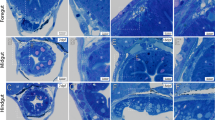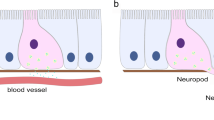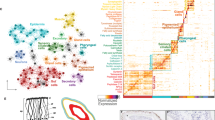Abstract
The interstitial cells of Cajal (ICCs) are important mediators of gastrointestinal (GI) motility because of their role as pacemakers in the GI tract. In addition to their function, ICCs are also structurally distinct cells most easily identified by their ultra-structural features and expression of the tyrosine kinase receptor c-KIT. ICCs have been described in mammals, rodents, birds, reptiles, and amphibians, but there are no reports at the ultra-structural level of ICCs within the GI tract of an organism from the teleost lineage. We describe the presence of cells in the muscularis of the zebrafish intestine; these cells have similar features to ICCs in other vertebrates. The ICC-like cells are associated with the muscularis, are more electron-dense than surrounding smooth muscle cells, possess long cytoplasmic processes and mitochondria, and are situated opposing enteric nervous structures. In addition, immunofluorescent and immunoelectron-microscopic studies with antibodies targeting the zebrafish ortholog of a putative ICC marker, c-KIT (kita), showed c-kit immunoreactivity in zebrafish ICCs. Taken together, these data represent the first ultra-structural characterization of cells in the muscularis of the zebrafish Danio rerio and suggest that ICC differentiation in vertebrate evolution dates back to the teleost lineage.









Similar content being viewed by others
Explore related subjects
Discover the latest articles and news from researchers in related subjects, suggested using machine learning.References
Braasch I, Salzburger W, Meyer A (2006) Asymmetric evolution in two fish-specifically duplicated receptor tyrosine kinase paralogons involved in teleost coloration. Mol Biol Evol 23:1192–1202
Chen H, Redelman D, Ro S, Ward SM, Ordög T, Sanders KM (2007) Selective labeling and isolation of functional classes of interstitial cells of Cajal of human and murine small intestine. Am J Physiol Cell Physiol 292:C497–C507
Davuluri G, Seiler C, Abrams J, Soriano AJ, Pack M (2010) Differential effects of thin and thick filament disruption of zebrafish smooth muscle regulatory proteins. Neurogastroenterol Motil 22:1100–e285
Edling CE, Hallberg B (2007) c-Kit—a hematopoietic cell essential receptor tyrosine kinase. Int J Biochem Cell Biol 39:1995–1998
Faussone-Pellegrini MS, Thuneberg L (1999) Guide to the identification of interstitial cells of Cajal. Microsc Res Tech 47:248–266
Garcia-Lopez P, Garcia-Marin V, Martínez-Murillo R, Freire M (2009) Updating old ideas and recent advances regarding the interstitial cells of Cajal. Brain Res Rev 61:154–169
Hennig GW, Spencer NJ, Jokela-Willis S, Bayguinov PO, Lee HT, Ritchie LA, Ward SM, Smith TK, Sanders KM (2010) ICC-MY coordinate smooth muscle electrical and mechanical activity in the murine small intestine. Neurogastroenterol Motil 22:e138–e151
Holmberg A, Olsson C, Hennig GW (2007) TTX-sensitive and TTX-insensitive control of spontaneous gut motility in the developing zebrafish (Danio rerio) larvae. J Exp Biol 210:1084–1091
Horowitz B, Ward SM, Sanders KM (1999) Cellular and molecular basis for electrical rhythmicity in gastrointestinal muscles. Annu Rev Physiol 61:19–43
Huizinga JD (1999) Gastrointestinal peristalsis: joint action of enteric nerves, smooth muscle, and interstitial cells of Cajal. Microsc Res Tech 47:239–247
Hultman KA, Bahary N, Zon LI, Johnson SL (2007) Gene duplication of the zebrafish kit ligand and partitioning of melanocyte development functions to kit ligand a. PLoS Genet 3:e17
Iino S, Horiguchi K (2006) Interstitial cells of Cajal are involved in neurotransmission in the gastrointestinal tract. Acta Histochem Cytochem 39:145–153
Kindblom LG, Remotti HE, Aldenborg F, Meis-Kindblom JM (1998) Gastrointestinal pacemaker cell tumor (GIPACT): gastrointestinal stromal tumors show phenotypic characteristics of the interstitial cells of Cajal. Am J Pathol 152:1259–1269
Klüppel M, Huizinga JD, Malysz J, Bernstein A (1998) Developmental origin and Kit-dependent development of the interstitial cells of Cajal in the mammalian small intestine. Dev Dyn 211:60–71
Komuro T (2006) Structure and organization of interstitial cells of Cajal in the gastrointestinal tract. J Physiol 576:653–658
Komuro T, Seki K, Horiguchi K (1999) Ultrastructural characterization of the interstitial cells of Cajal. Arch Histol Cytol 62:295–316
Krementz AB, Chapman GB (1975) Ultrastructure of the posterior half of the intestine of the channel catfish, Ictalurus punctatus. J Morphol 145:441–482
Matsuda M, Chitnis AB (2010) Atoh1a expression must be restricted by Notch signaling for effective morphogenesis of the posterior lateral line primordium in zebrafish. Development 137:3477–3487
Mellgren EM, Johnson SL (2005) Kitb, a second zebrafish ortholog of mouse Kit. Dev Genes Evol 215:470–477
Merlino G, Khanna C (2007) Fishing for the origins of cancer. Genes Dev 21:1275–1279
Min KW, Leabu M (2006) Interstitial cells of Cajal (ICC) and gastrointestinal stromal tumor (GIST): facts, speculations, and myths. J Cell Mol Med 10:995–1013
Miyamoto-Kikuta S, Komuro T (2007) Ultrastructural observations of the tunica muscularis in the small intestine of Xenopus laevis, with special reference to the interstitial cells of Cajal. Cell Tissue Res 328:271–279
Parichy DM, Rawls JF, Pratt SJ, Whitfield TT, Johnson SL (1999) Zebrafish sparse corresponds to an orthologue of c-kit and is required for the morphogenesis of a subpopulation of melanocytes, but is not essential for hematopoiesis or primordial germ cell development. Development 126:3425–3436
Rich A, Leddon SA, Hess SL, Gibbons SJ, Miller S, Xu X, Farrugia G (2007) Kit-like immunoreactivity in the zebrafish gastrointestinal tract reveals putative ICC. Dev Dyn 236:903–911
Robson ME, Glogowski E, Sommer G, Antonescu CR, Nafa K, Maki RG, Ellis N, Besmer P, Brennan M, Offit K (2004) Pleomorphic characteristics of a germ-line KIT mutation in a large kindred with gastrointestinal stromal tumors, hyperpigmentation, and dysphagia. Clin Cancer Res 10:1250–1254
Rumessen JJ, Vanderwinden JM (2003) Interstitial cells in the musculature of the gastrointestinal tract: Cajal and beyond. Int Rev Cytol 229:115–208
Vanderwinden J-M, Rumessen JJ, Bernex F, Schiffmann SN, Panthier J-J (2000) Distribution and ultrastructure of interstitial cells of Cajal in the mouse colon, using antibodies to Kit and Kit W-lacZ mice. Cell Tissue Res 302:155–170
Wallace KN, Akhter S, Smith EM, Lorent K, Pack M (2005) Intestinal growth and differentiation in zebrafish. Mech Dev 122:157–173
Wang Z, Du J, Lam SH, Mathavan S, Matsudaira P, Gong Z (2010) Morphological and molecular evidence for functional organization along the rostrocaudal axis of the adult zebrafish intestine. BMC Genomics 11:392
Watson HD (1981) The ultrastructure of the innervation of the intestinal wall in the teleosts Myoxocephalus scorpius and Pleuronectes platessa. Cell and Tissue Res 214:651–658
Wu JJ, Rothman TP, Gershon MD (2000) Development of the interstitial cell of Cajal: origin, kit dependence and neuronal and nonneuronal sources of kit ligand. J Neurosci Res 59:384–401
Author information
Authors and Affiliations
Corresponding author
Additional information
Portions of this work were generously funded by the National Institutes of Health including NIH DK071588-02; the remaining of this work was funded by the Intramural Program of NICHD, NIH.
Electronic supplementary material
Below is the link to the electronic supplementary material.
Supplemental Movie 1
Three-dimensional reconstruction of the whole-mount zebrafish intestine at 7 days post-fertilization (dpf). A single kit-positive cells (green) is seen in the developing intestine, closely associated with a rich neural network of acetylated tubulin-stained cells (red). Hoechst was used as a nuclear counterstain (blue) (MOV 1442 kb)
Supplemental Movie 2
Three-dimensional reconstruction of the zebrafish intestine at 7 days post-fertilization (dpf) cut in cross section. Although few in number, kit-positive cells (green) are seen in the developing intestine near the right middle quadrant of the outermost border of the intestine, together with a rich neural network demonstrated by acetylated tubulin staining (red) and Hoechst nuclear stain (blue). Superior to the intestine, kit-positive cells are also seen in the developing nephric tubules (MOV 3228 kb)
Rights and permissions
About this article
Cite this article
Ball, E.R., Matsuda, M.M., Dye, L. et al. Ultra-structural identification of interstitial cells of Cajal in the zebrafish Danio rerio . Cell Tissue Res 349, 483–491 (2012). https://doi.org/10.1007/s00441-012-1434-4
Received:
Accepted:
Published:
Issue Date:
DOI: https://doi.org/10.1007/s00441-012-1434-4




